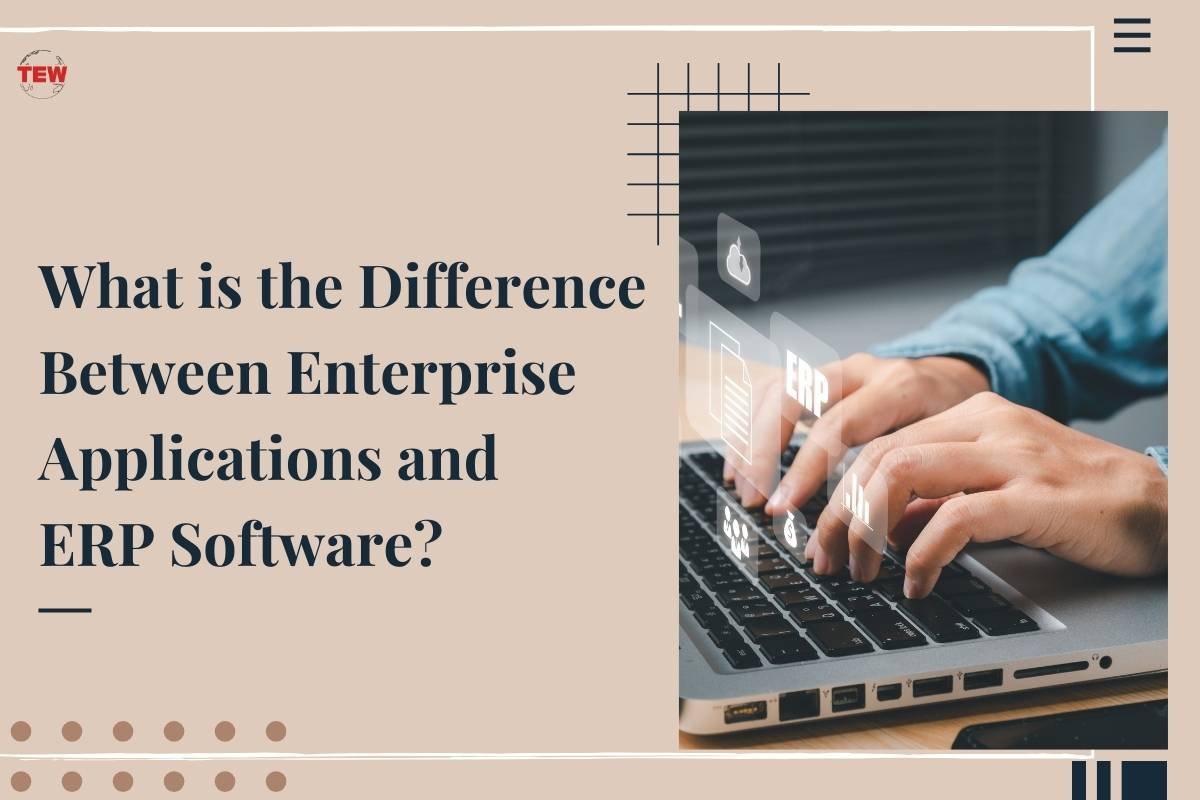Digital transformation has become a vital competitive lever with companies striving to modernize core business applications and unlock new operating models. Approximately 783 billion U.S. dollars are estimated to be spent on enterprise software worldwide by 2022 underscoring the magnitude of investments being poured into transforming application landscapes. But not all software deployments are created alike – two very common and yet distinct enterprise toolsets are enterprise applications versus dedicated ERP (Enterprise Resource Planning) systems. This article analyzes their similarities and differences.
Differences in Scope of Enterprise Applications and ERP Software

Enterprise applications cover a vast array of end-to-end digital solutions built specifically to manage business operations or deliver differentiated customer value propositions using modern technologies like cloud, AI/ML, mobile, and blockchain. Procure-to-pay tools, custom CRM, proprietary optimization engines, partner portals, and e-commerce websites built in-house are all examples of bespoke enterprise application development tailored to solve specific problems at scale using software.
ERP systems on the other hand are focused squarely on improving operational excellence in transaction-heavy back-office environments, namely finance, HR, manufacturing, supply chain, and procurement domains. ERP suites add tremendous business value through an integrated suite allowing data to seamlessly flow across different functions in an automated fashion aiding reporting, compliance, process improvement, and strategic planning. Market incumbents include SAP, Oracle, Microsoft Dynamics, and more.
Given the complexities involved in deploying these systems, seeking expert help can be a strategic decision. For those who use Microsoft Dynamics, Dynamics ERP development services offer customized solutions that enhance system performance and customization, helping businesses meet their unique requirements. This approach not only streamlines operations but also ensures that the ERP system evolves with your business needs.
Contrast the Degree of Customization
A major benefit of developing proprietary enterprise software is complete flexibility to customize it to support any process, capability, or data structure required to meet exact business needs. This allows competitive differentiation versus off-the-shelf solutions forcing all customers into the same mold. With enterprise applications, companies control the roadmap and pace of enhancements rather than being at the mercy of annual vendor releases and licenses.
ERP systems are commercial software packages so inherently less customizable at their core. Vendors do allow some changes to basic data schemas, workflows, reporting, dashboards, and integration extensions but they have to cater to the broader customer base. Highly specialized custom logic may be harder to embed without complication. But modern ERPs are more configurable with low-code tools allowing citizen developers to tailor functionality like workflows, forms, and basic rules.
Understanding Vendor Dependencies

When weighing build versus buy decisions for enterprise applications, another factor is minimizing reliance on external entities. Inhouse development or hiring reputed system integrators allows strategic control over intellectual property and value creation levers – balancing capital versus operating expenses. Key technical expertise also stays nurtured in-house. However, it requires strategic long-term IT investments in talent and tools. If business requirements are highly stable, custom apps make sense.
Meanwhile, commercial ERP vendors own the software IP and mandate recurring licensing which erodes flexibility. They control the development roadmap. However, the total cost of ownership can be quantified more transparently upfront. Being platform agnostic, upgrades and migrations are facilitated. If requirements fluctuate or deep technical skills are unavailable internally, opting for third-party ERP systems may work. Hybrid models blending ERP with custom modules also exist.
Comparing Integration Architectures
Enterprise systems almost always have to coexist alongside legacy systems and adjuvant applications – the technical debt accrued over decades, especially in established industries. Custom applications lend themselves more seamlessly to flexible integration frameworks through modern APIs. ERPs focus heavily on centralized data consumption and analytics meaning they force legacy tools into their proprietary integrations or databases which can get complex fast.
The latest ERP versions have opened up significantly leveraging APIs, cloud microservices, and real-time data streaming. However, the burden of migrations from incumbent ERPs and harmonizing interfaces across hybrid transactional/analytical systems bears strategic consideration beyond purely technical synergy. Transforming disjointed application sprawl into connected digital ecosystems remains an intricate balancing act.
Understanding Usage Scenarios and Users

The types of business processes served and user adoption requirements greatly influence software option analysis. ERP software predominantly enhances the productivity of internal employees by standardizing operations, reporting, and information access across departments. They are back-office-centric. Enterprise applications on the other hand may also have extensive external stakeholder interactions – B2B software for partners, online customer portals, or sales apps used by field reps. So user experience and interfaces have to mimic real-world workflows.
Evaluating the Total Costs
Upfront license purchases and ongoing maintenance fees for ERP software can rack up significantly, not to mention expensive customization, training, and upgrades. However, the costs are relatively transparent at procurement. The appeal is the predictability of TCO if vendors deliver on promised roadmaps. With enterprise application development, speculative budgeting is hard. Timelines can be longer but value creation levers are retained inhouse post-implementation minus recurring licensing fees. Companies have to judiciously assess trade offs based on competencies, capabilities, user needs, and finances.
Summary
| Parameter | Enterprise Application | ERP System |
| Scope | Broad set of software solutions solving specific business problems | Focused on optimizing back-office operations – finance, HR, supply chain, etc. |
| Customization | Highly customizable to unique needs | Limited flexibility as off-the-shelf commercial packages |
| Ownership | Can be developed in-house or by system integrators | Owned by vendor companies like SAP, Oracle, etc. |
| Integrations | API-based integration with other systems | Centralized data hub forcing systems into ERP |
| Users | May have extensive external user base | Optimized for internal employee productivity |
| Costs | High upfront development costs | Large recurring licensing, maintenance and upgrade fees |
| Timelines | Longer development but controlled roadmap | Faster implementations but dependent vendor releases |
| Best For | Unique solutions requiring control and flexibility | Generic back-office processes open to standardization |
In summary, while enterprise software is a broad umbrella term, ERP systems represent a distinct subset laser-focused on operational process optimization, integration, and analytics. Deep ERP capabilities offered by vendors have a place in driving back-office efficiencies across finance, HR, manufacturing floors, and inventory workflow – functions that lend themselves well to standardized platforms benefitting from uniform centralized data. Bespoke enterprise apps powered by modern architectures allow creative customer-facing solutions or competitive differentiators where uniqueness and control outweigh off-the-shelf reliability. As digitalization proliferates across industries, having clarity on selecting, building, or buying various enterprise software components becomes mission-critical.




